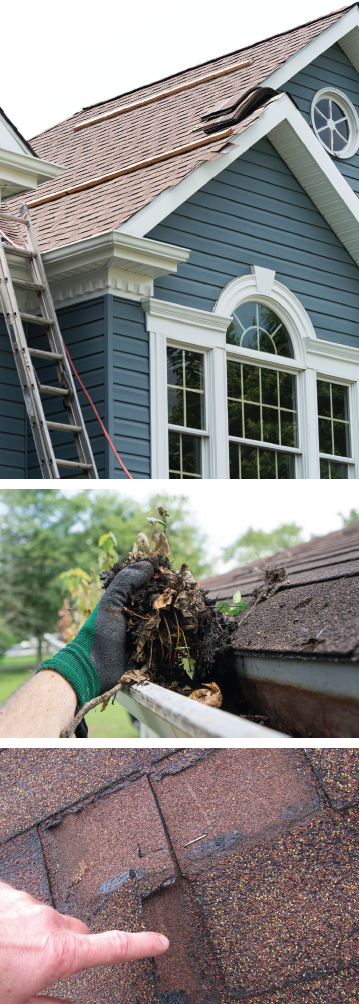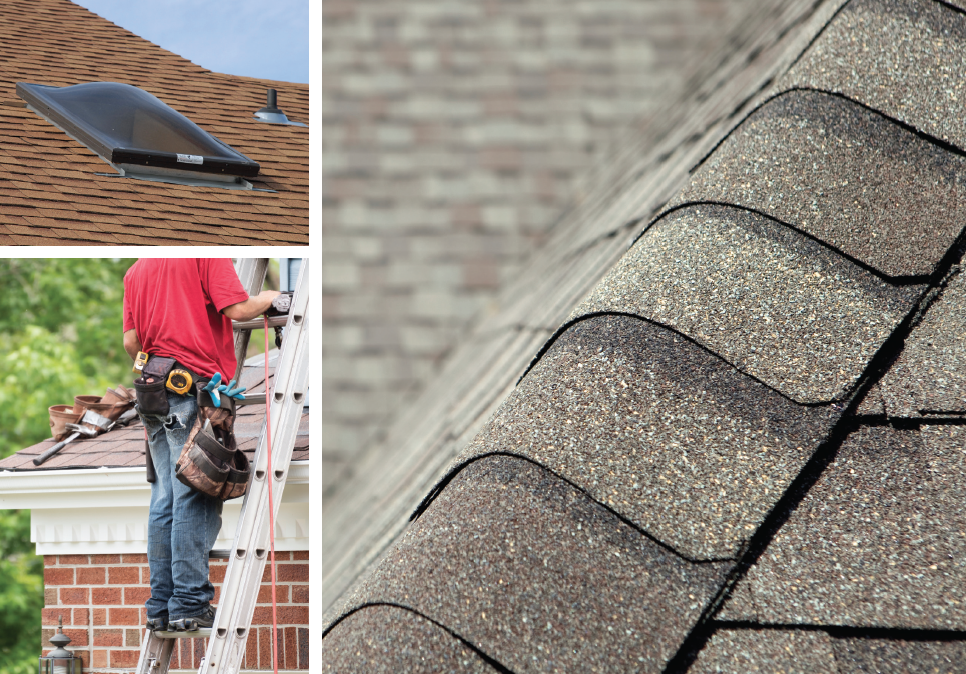Roof Care: Protect the Roof That Protects You

Every homeowner dreads discovering that the roof overhead needs major repair or replacement. Roof work is a significant expense, and one for which only the most foresighted earmark savings. So it behooves us all to think about how to extend the serviceable life of the roof that’s now keeping us dry.
Roofing experts tell us there are steps we can take that will keep our roofs looking and performing better, longer. Here, we share tips—some obvious, some just shy of “classified information.”
- Keep foot traffic on the roof to a minimum. Shingles depend on the granules molded into their surface during manufacturing. Foot traffic, especially on a sloped roof, dislodges some of that protective surface. Make sure there’s no unessential traffic on your roof, and if a satellite dish technician or chimney or gutter guy must go up there, ask them to wear minimally destructive footwear.
 Watch for collecting leaves and other tree debris in the “valleys” of your roof and have a professional remove them if necessary. Leaf buildup can lead to roof leaks, and decomposing material makes for ugly tannin stains. If you have a maintenance contract with your roofer, removal of this debris should be included.
Watch for collecting leaves and other tree debris in the “valleys” of your roof and have a professional remove them if necessary. Leaf buildup can lead to roof leaks, and decomposing material makes for ugly tannin stains. If you have a maintenance contract with your roofer, removal of this debris should be included.- Gutter cleaning is important. Clogged gutters cause water to back up, possibly seeping under shingles and causing leaks that damage walls. Have gutters checked and cleaned twice a year, or as necessary, to keep runoff flowing freely. Consider screening to keep out leaves, “pinwheels,” and other tree materials.
- Do not allow your shingle roof to be “power washed.” High-pressure washing strips the roof of material that is key to its longevity. Fungus and mold can be safely removed by what is termed “soft washing,” a service some roofers offer.
- Roof leaks most often come from failed or improperly installed flashing around dormers, chimneys, skylights, plumbing vents and satellite dishes. If water is coming in, have a qualified expert check these areas and repair or replace flashing as needed.
- What’s in attics can be a source of roof problems. Improper ventilation, condensation, and animal or bug infestations can lead to issues with roof performance. An occasional peek into the attic with flashlight in hand can disclose developing problems before the roof itself is affected. Look especially for algae stains, mold, soaked insulation, black rings or rust
around nails (a sure sign of condensation in attic spaces), and clogged air exchange vents. - Have shingles checked after a hailstorm. Large, windblown hailstones can dent shingles, break edges and wear down their surface, severely reducing their useful life. If a hailstorm has hit yours, have them checked shortly after. Your homeowners insurance should cover any repairs, including roof replacement if damage is severe.
Special Advice For Metal Roofs
 With metal roofs, foot traffic won’t cause the kind of damage it does to shingle roofs, but it can produce scratches, dents and other harmful alterations. Here again, hiring trained experts for inspections and repairs is by far the safest approach. Besides, metal roofs can be slippery, and whenever homeowners take to a ladder to access anything, they are at risk of finishing their day in the hospital.
With metal roofs, foot traffic won’t cause the kind of damage it does to shingle roofs, but it can produce scratches, dents and other harmful alterations. Here again, hiring trained experts for inspections and repairs is by far the safest approach. Besides, metal roofs can be slippery, and whenever homeowners take to a ladder to access anything, they are at risk of finishing their day in the hospital.
That said, here are some metal roof checkpoints:
- Repair holes and open seams as soon as possible. As your metal roof expands and shrinks with weather extremes, screws become loose, and seams may separate. If this issue is not quickly addressed, your roof’s underlying structure could be damaged by condensation and water buildup around stacks. In order to prevent damage due to seam leaks, remember to inspect your home’s roof at least twice a year and after severe storms. Watch for signs of loose hardware and obvious seam separation.
- Keep paint touched up so that corrosion won’t develop. An exposed steel surface will quickly rust and become unsightly. There are non-corrosion treatments that will also fight this form of roof decay.
- Fasteners should be replaced when they reach the end of their expected service lives—usually 20 to 30 years.
- Inspect and replace sealants at perimeters and wherever something protrudes through the roof surface. Most sealants last about 20 years, though some butyl sealants retain their bond and elasticity far longer. Your roof inspector can tell which you have.
- If screws are used for repairs, make sure they are of the same metal as the roof itself. Two dissimilar metals in close proximity set up the potential for galvanic corrosion, which eats away at one or both metals.
Cedar Shake Roofs
 Popular with many homeowners due to their distinctive appearance, roofs of cedar and redwood shakes can add a high-end, luxury look to homes of many designs. Cedar roofs do require regular maintenance to prevent moss, mold and mildew growth. However, there are cedar treatment preservatives that can be added during the crafting process to prevent fungal growth and preserve the wood. Cedar roofing care is a specialty, so inspections and repairs need to be handled by contractors with the proper training and experience.
Popular with many homeowners due to their distinctive appearance, roofs of cedar and redwood shakes can add a high-end, luxury look to homes of many designs. Cedar roofs do require regular maintenance to prevent moss, mold and mildew growth. However, there are cedar treatment preservatives that can be added during the crafting process to prevent fungal growth and preserve the wood. Cedar roofing care is a specialty, so inspections and repairs need to be handled by contractors with the proper training and experience.
As with most home systems, spending time and resources on some preventative maintenance is usually well spent. Invest in developing a maintenance plan for your roof—periodic inspections (generally in the fall and spring), routine maintenance, and minor repairs as needed to keep small problems from becoming major and costly roof issues later on.








